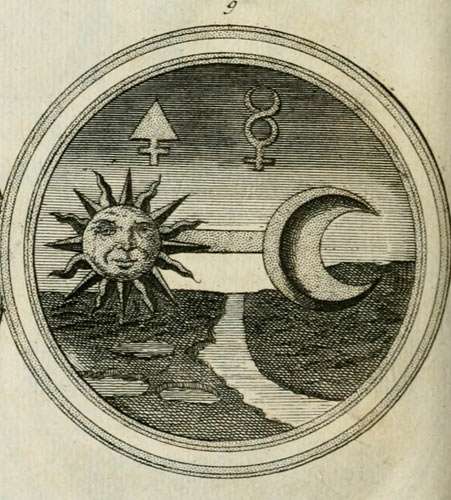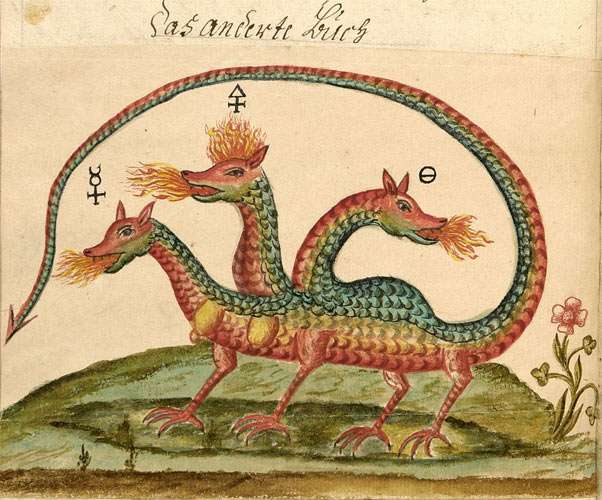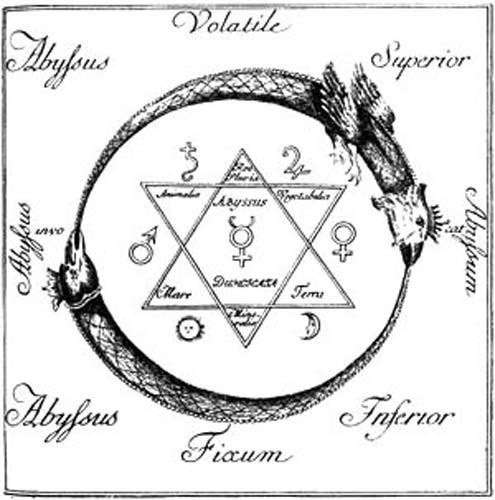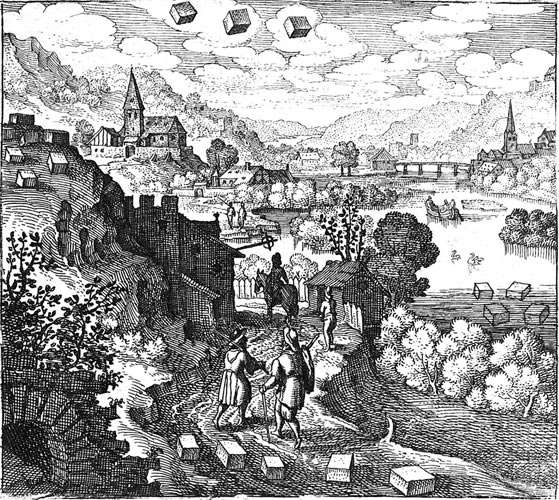

This article is also available in PDF format.
|
The secret of alchemy is this: there is a way of manipulating matter and energy so as to produce what modern scientists call a 'field of force.' The field acts on the observer and puts him in a privileged position vis-a-vis the Universe. From this position he has access to the realities which are ordinarily hidden from us by time and space, matter and energy. This is what we call the Great Work. Fulcanelli, 1937 |
|
Contents The Ripening of Metals into Gold The Underlying Subtle Elements Modern Analysis of Alleged Transmuted Silver Particle Accelerators and Nuclear Reactors |
|
Not much explanation is necessary to point out that when an alchemist claimed to be able to transmute a base metal into silver or gold, that this sparked the interest of powerful people, such as kings, and emperors. Monarchs are eager to replenish their coffers, and charlatans are eager to deceive them. There are plenty of stories of 'successful' transmutations in front of witnesses. Some monarchs spent a lot of money on building a laboratory for the alchemist, supplying him with everything he wanted. But sometimes the alchemists didn't live up to their claims, and they fled or were executed. True alchemists experimented a lot and sometimes came up with unsuspecting results. Some metallurgists knew how to make a metal look like gold, as long as they were honest about it they were honorable alchemists. But others were not so honest and knew many different ways to fake transmutations. These practices of making metals look like gold date back to the Arab alchemists, and were considered an art by itself, written about in several books. Western alchemists also read those books, and used the information for their dishonest purposes.
The workshop of the Swiss alchemist Leonhard Thurneysser is visited by the archduke Johann Georg Date circa 1590
|
|
The Ripening of Metals into Gold Khalid ibn Yazid in his Book of the Three Words (Liber trium verborum Kalid regis, Manget, Vol. II), says that nature always tries to develop metals into the most perfect form of silver or gold, but is often unsuccessful because matter contacts some 'disease' or 'corruption' from its surroundings; and alchemy is the art of perfecting these imperfect metals. Among alchemists, there was a widespread belief that base metals could indeed be transmuted into silver and gold. They claimed that metals turn into one another in an evolutionary process in nature that takes a very long time. The alchemists sought to hasten that process in a laboratory. Gold always played a great role in diverse cultures because of its unique properties. It is the most malleable and ductile of all metals. It is also quite inert and does not rust. It was used for making jewelry and it had a monetary value. Gold jewelry was worn and enjoyed. Gold coins served as a means for purchasing goods, but also instigated greed. Since ancient times, gold was considered to be the most perfect of all metals, and was often associated with gods. Gold has always been a symbol of immortality because it does not corrode or oxidize. Gold is very valuable because it is rare in nature, so other means of obtaining were sought, namely by transmuting other metals. Alchemy was basically exploration into chemistry, but the belief that metals could be transformed into silver and gold, gave it a whole different mystical aura. Because this led to even more experimentation, it is not always clear in what alchemists were actually engaged, or what results they obtained. At the same time alchemy also encompassed a holistic outlook on life, creation, and the composition of matter and inanimate objects. Alchemy in its broadest sense is a mixture of chemistry, metallurgy, mysticism, philosophy, religion, astrology and various occult sciences. Transmutation, in the spiritual sense, is to transform man into a spiritual being and to promote health and a long life, and in a physical sense of transforming base metals in silver and gold. The latter might not be possible or might have never happened in a laboratory, but alchemists were convinced that it was possible based on an underlying philosophical outlook about the composition of matter. So experiment they did, but we will never know for sure if they did indeed succeeded in their intended transmutations, despite many claims and stories. Although many lost all their money in the process, others did discover new procedures and new materials. It was the search for the mysterious, the unknown and what might be possible that was important. Alchemists believed that metals grow in the earth, changing one into another. A very slow process that could be produced much more quickly in a laboratory. Was this a misinterpretation of extracting metals out of their ores? Since ancient times it was believed that everything was alive, and that even 'inanimate matter' such as rock and metals also had a spirit of life in them. In this growing process, gold was the end stage. All metals would eventually ripen into gold. This only happens inside the earth. Once they are mined and are above the earth, they are subject to rust and deterioration. All metals had a seed of gold in them. If you could manipulate that seeds then you could transform them into gold. At least some chemical reactions were not quite understood. For example, the deposition of copper (using blue vitriol or bluestone) on iron metal when placed in a solution of copper sulfate was known since the time of Pliny the Elder (AD. 23?-79), and was assumed to be a transmutation of iron into copper until the late Renaissance. It is actually a chemical redox reaction (one species undergoing oxidation while another species undergoes reduction). But blue vitriol or bluestone, which is copper sulfate, was not known to contain copper. Another example is Galena (lead sulfide) which is an ore which on heating, liberates sulfur dioxide, and lead remains. Since silver is often present as an impurity in galena, silver is also obtained by this process.
Detail of the frontispiece of Metamorphosis Planetarum, by Johannes De MonteSnyders, 1774 Monte Snyder was himself a practical laboratory alchemist, known across Europe in his day for the various transmutations he performed. The book is an alchemical allegory of the transmutation of metals. As an allegory it links together the spiritual side of alchemy with actual physical laboratory processes.
The Underlying Subtle Elements Belief in alchemical transmutation persisted, and was based on the theory of the elemental composition of all materials. We find this theory in various cultures, with some minor differences. The Chinese believed that all physical matter was composed of five elements: water, fire, wood, metal and earth. The Chinese alchemists were more interested in producing the Elixir of Life which would bring the body into perfect harmony with the way of the universe. The Western alchemists, most likely based on the ancient Greek philosophers limited themselves to the four elements of earth, water, air and fire. Every kind of metal or mineral had a different amount of each of the elements. If you are able to change the amounts of the elements, you will end up with a different material. |

The Four Elements, and their symbols,
from Philosophia Reformata (1622) by Johan Daniel Mylius
|
The Arabs introduced the Sulfur-Mercury theory. The alchemist Jabir (9th century) was the first one who believed that, under the influence of the planets, metals were formed in the earth by the union of sulfur (providing the hot and dry natures) and mercury (providing the cold and moist). The sulfur and mercury are not always pure, so they do not always unite in the same proportion in different metals. When they are perfectly pure, and if also they combine in the most complete natural equilibrium, then the product is the most perfect of metals, namely gold. Defects in purity and, particularly, proportion result in the formation of silver, lead, tin, iron, or copper. Since these inferior metals are essentially composed of the same constituents as gold, the accidents of combination may be rectified by suitable treatment. Such treatment, according to Jabir, is to be carried out by means of elixirs. This concept that the metals are composed of mercury and sulfur was generally accepted by later generations of alchemists and chemists and remained a part of alchemy and chemistry even into the eighteenth century. Mercury and Sulfur are to be regarded as qualities: Mercury has the quality of volatilization and sulfur that of fixation. Jabir also held to the four elements theory, the elements being more like qualities of hot, moist, dry and cold. |

Sulfur and Mercury as inseparable qualities.
From Elementa Chimiae quibus subjuncta est confectura lapidis philosophici imaginibus repraesentata by Johann Conrad Barchusen, 1718
|
In the early 16th century Philippus Aureolus Theophrastus Bombastus von Hohenheim (1493-1541), a Swiss physician and alchemist who called himself Paracelsus, introduced his Tria Prima. It consisted of the Mercury-Sulfur theory with Salt added as the third quality. Paracelsus did not attach much importance to the classic four elements. Paracelsus considered Sulfur to be Fire or the Soul, Mercury is water of the Spirit, and Salt is the earthly Body. Paracelsus was mainly a physician and thus held to the trinity of of Soul-Spirit-Body. Again differences in metals are explained as differences in the composition of the Mercury, Sulfur, and Salt of each metal. Change the combination and you are able to transmute one metal into another. |

Trinity of 🜍 Mercury, 🜍 Sulfur and 🜔 Salt
from Clavis Artis, attributed to Zoroaster, 17th century
|
Regardless of the system of underlying elements, the basic idea was that changing the relative amount of the elements one could transmute one body into another. But this applied only to metals, not other objects or beings. The 13th century Arab alchemist Abuíl-Qasim Muhammad ibn Ahmad al-Iraqi said in his Book of Knowledge Acquired Concerning the Cultivation of Gold (transl. by E. J. Holmyard, Hamdard, 1977, 20, 7-68): KNOW, may GOD have mercy on thee that the materials used in the Art of Chemistry are of one species essentially. They are called the metallic minerals and subdivided into six sorts varying in form and in properties, but not immutable as are individual animals and plants. They are gold, silver, copper, iron, lead and tin. Each of them is marked off from the others by accidental distinguishing properties, and it should be possible to effect the necessary removal of these properties the specific nature remaining constant. We say and maintain that two species of natural things which differ radically and essentially cannot be changed and converted one into the other by the Art as, for example, man and the horse. But these six bodies can be mutually converted. It is possible (for example) for a part of the lead to be changed into silver. In the same way silver may be converted into gold. But if silver differed from gold in species it would not be possible to convert it into it, just as it is impossible to convert a horse into the human species by the Art, because they differ radically and essentially. These six metallic forms are all of one species, distinguished from one another only by differentiating accidental qualities; their extreme limit is reached when they become gold. Now that which is free from any accidental quality is gold, while what possesses these becomes either silver or the two leads if it has the quality of coldness, or copper or iron if it has the quality of hotness. All the metals were considered of to be of the same underlying nature. That is why they can be transmuted by changing their underlying composition of the elements, which are sometimes associated with the qualities dryness, wetness, coldness and heat. But these transmutation required the presence of the Philosopher's Stone. Pure chemical reactions did not produce transmutations, although some alchemists mistakenly believed this due to lack of understanding. |

The seven metals and their planetary signs
from Donum Dei, 1735, anonymous
|
In order to cause a transmutation of metals into gold, the philosopher's stone (lapis philosophorum) was needed. Thus the search for or the making of the philosopher's stone was central to the alchemist's quest. The problem was the identity of the philosopher's stone. It could be a powder, a liquid or a solid. The philosopher's stone is the most known term for this mysterious substance, but it had many other names: the Projection Powder, Elixir, Tincture, Universal Essence, Quintessence, Stone of the Wise, Universal medicine, etc. There are some six hundred names for it. But that thing called Philosopher's Stone, Universal Medicine, Golden Panacea, does it exist in reality as well as in speculation? Why, through the ages, have so many persons, whom Heaven seems to have favored with knowledge superior to that of most men, sought it in vain? But, on the other hand, so many trustworthy historians, so many wise men have attested its existence, and have left in enigmatic writings and allegories the method of making it which can scarcely be doubted, when one knows how to adapt these writings to the principles of Nature. (Dom Pernety in A Treatise on the Great Art) The Philosopher's Stone has been given so many descriptions, that it is impossible to figure out what kind of object or material it might be. Or is it physical at all? Sometimes it is said that it is both spiritual and corporeal. The alchemists lived in a time when science and spirituality were not separated. The physical and the spiritual were seen as intimately connected. Alchemical texts contained at times spiritual or religious phrases. Spirituality was sometimes seen as necessary in the Great Work. Some alchemists claimed that the Philosopher's Stone is everywhere: All persons that have once heard of the name or power of the Stone, unless altogether incredulous, ask where it may be found, that so they may run directly to it. The Philosophers answer is twofold: First Adam brought it with him out of Paradise, that is, in you and in me, and in every man that, birds flying, bring it with them out of far countries. Secondly, it may be found in the Earth, Mountain, Air and Rivers. Which path therefore must be taken? (Atalanta Fugiens, 1618, by Michael Maier, commentary on 36th emblem.) 
Atalanta Fugiens, Emblem 36, Michael Maier The Stone that is Mercury, is cast upon the Earth, exalted on Mountains, resides in the Air, and is nourished in the Waters. Did the alchemists (at least some) know that it is life energy that can transmute metals? Could it be that some subtle energies are involved? After all, they believed that everything, even physical 'inert' metals, were imbued with life force. The philosopher's stone was not only able to transmute base metals into silver and gold, but as an Elixir of Life it could cure all diseases and prolong life. Some alchemists added other qualities to it such as the ability to understand the language of animals, changing ordinary stones into precious stones, and soften every kind of glass. Here we are touching again the spiritual side of alchemy, where a transformed man is believed to have greater psychic abilities. So maybe it is the life energy, or the subtle energies underlying the physical world, that are responsible for physical transmutations. As an anonymous alchemists wrote in his Glory of the World: It is familiar to all men, both young and old, it is found in the country, in the village, in the town, in all things created by God; yet despised by all. Rich and poor handle it every day. It is cast into the street by servant maids. Children play with it. Yet no one prizes it, though, next to the human soul, it is the most beautiful and the most precious thing upon earth, and has power to pull down kings and princes. Nevertheless, esteemed the vilest and meanest of earthly things, it is cast away and rejected by all. Some alchemists wrote down cryptic procedures to make this philosopher's stone, so maybe this was an attempt to somehow condense the life force into a physical material. According to some authorities, it was absolutely necessary that the philosopher's stone be enveloped in wax to produce a transmutation. The color of the produced philosopher's stone was usually described as being of red or ruby like color, but other colors were also attributed to it. Others claimed that the Great Work to produce the stone had to be in accordance with astrological elements or celestial influences..
Modern Analysis of Alleged Transmuted Silver Four scientists published the result of their examinations of one silver coin and five silver medals which have been claimed to be the result of a base metal transmuted into silver. In their publication, Search for isotopic anomalies in alchemical silver coins from the Germanischen National Museum in Nuremberg (2006) they explain that silver has two stable isotopes. These two isotopes always have the same ratio: 51.839 % for Ag-107 and 48.161 % for Ag-10. This is always the same no matter from what mine in the world the silver has come. If silver is produced by artificial means, then this ratio will be different, which has been show with experiments of low energy nuclear reaction by electrolysis, resulting in the transmutation of certain elements. When the coin and medals were examined, they showed that they all had the same silver isotope ratio, as natural silver from a silver mine. So these were not the result of an artificial transmutation. At least not for those six specimens, chosen out of a total of 34 alchemical coins and medals conserved in the museums of Nuremberg, Wien, Dresden and Munich. It is not possible to do the same analysis for gold, because only has one stable isotope.
Transmutation involves a change in the nucleus, or core, of an atom. When the number of protons in an atom is changed, the atom is transmuted into an atom of another element. Natural transmutation occurs in unstable, radioactive elements, which decay into a series of other elements until a stable element is formed. Nuclear transmutation was first discovered by Frederick Soddy in 1901, when he, along with Ernest Rutherford, discovered that radioactive thorium was converting itself into radium. Another example is uranium 238, it spontaneously transmutes into lead 206, which is stable. Radioactive decay causes the loss of nuclear particles, thereby causing the transmutation. The half-lives of radioactive atoms have a huge range; from nearly instantaneous to far longer than the age of the universe.
Particle Accelerators and Nuclear Reactors Artificial transmutation occurs when an existing element is collided with high speed particles to form another element. Artificial transmutation requires science and expensive equipment, it is a human engineered process. Lead can be turned into gold by artificial nuclear transmutation, but only in extremely small amounts. Nuclear scientists at the Lawrence Berkeley National Laboratory (LBNL) in California succeeded in producing very small amounts of gold from bismuth, a metallic element adjacent to lead on the periodic table. The same process would work for lead, but isolating the gold at the end of the reaction would prove much more difficult. Gold has 79 protons, nearby lead (on the periodic table of elements) has 82 protons. Mercury is even closer, it is situated next to gold having 80 protons. Is it coincidence that lead and mercury play such a prominent role in alchemy? Sherr, Bainbridge, and Anderson created gold in 1941 by shooting neutrons at mercury, neutrons that were generated by a series of nuclear reactions that were kick-started by the Harvard cyclotron particle accelerator (Harvard University, Cambridge, Massachusetts). Nuclear reactors cause fission products. When an atom splits into two parts, either through natural decay or when instigated within a lab, it releases energy. This process is known as fission. Ruthenium and rhodium are precious metals produced by nuclear fission of Uranium, and are a small percentage of the fission products. Palladium is also produced by nuclear fission in small percentages. Silver is produced as result of nuclear fission in small amounts (approximately 0.1%). The vast majority of produced Silver is Ag-109 which is stable, and Ag 111 which decays away very quickly to form cadmium Cd 111. Other elements obtained are rhenium, osmium, iridium, platinum, and as we mentioned before gold. Gold can currently be manufactured in a nuclear reactor by the irradiation of either platinum or mercury.
Transmutations by Modern Scientific Experiments When alchemy was largely discarded by the scientific community, some scientists were still interested in performing transmutations of certain elements into other elements by various methods during the 19th and 20th century. These experiments were conducted by chemical means, catalytic alloys, or high voltage electric treatments. Some of the results were found to be due to contamination of the samples, others were not repeatable, while still others were not pursued further. You can read of these manifold transmutation experiments in the book Adept Alchemy, by Robert A. Nelson. Cold fusion or low-energy-nuclear reaction (LENR) is a term used for scientific experiments that allegedly show that transmutation can occur in electrolysis cells at room temperature in laboratory conditions. It started in 1989, but was heavily criticized because other scientists were not able to reproduce the results. A 1991 review by a cold fusion proponent had calculated "about 600 scientists" were still conducting research. After 1991, cold fusion research only continued in relative obscurity, conducted by groups that had increasing difficulty securing public funding and keeping programs open. Their publications often do not reach mainstream scientific journals. Are those modern scientists the new alchemists chasing after the goose with the golden eggs?
Could Nature, being animated by the life force, do the same, by a simple process? The French scientist Louis Kervan did a lot of experiments that proved that atoms are being transmuted (probably by microbes) in soil, in animals and even in humans. He published several books. There is one book in English about his findings, called Biological Transmutations. According to Kervran, the lighter elements will transmute and only with elements with which they can gain or lose a proton and some combine H. For example Mg increases by Na11 + H1 which becomes Mg12. And, M12 +O8 becomes Ca20 in a reversible transmutation. With biological transmutations, the problem for scientists is that they can only measure the the amount of the elements before and after the transmutation. We are dealing with living systems, and they can't be examined in a controlled, totally isolated 'scientific' manner. This makes it difficult to study living systems with traditional chemistry and physics. There might be many factors involved and we have no clue what they might be. Production of silver or gold through biological transmutation is not reported. Maybe it is not possible or nature doesn't need it to sustain life. |